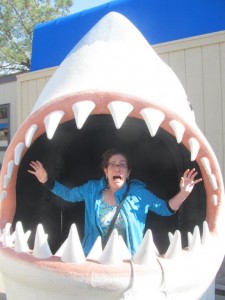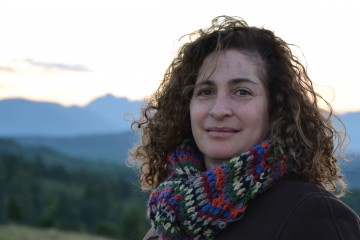By Helaine Becker
I love science. And writing. And kids. So it is not strange that when I began my career as a professional writer, I gravitated toward writing science for children.
No one really knows how many science books for kids are produced and sold each year – there aren’t good statistics. But even without the numbers in hand, a quick look at any school library’s shelves will reveal the answer: it’s a LOT.
In addition, most of those titles need to be replaced regularly. The market, it turns out, is insatiable for up-to-date books on popular topics. The demand for dinosaur books, for example, never goes extinct.
But cranking out yet another “All About T-rex” title isn’t the answer. Books for kids have evolved since the heyday of Dr. Seuss and Curious George. In the current environment, a same-old, same-old presentation simply can’t compete.
 Even though I’d cut my teeth in the publishing and school supply industries, it still took me years of trial and error to identify what was required in today’s marketplace. This is what I discovered – the key characteristics of top-notch, top-selling, contemporary science books for kids:
Even though I’d cut my teeth in the publishing and school supply industries, it still took me years of trial and error to identify what was required in today’s marketplace. This is what I discovered – the key characteristics of top-notch, top-selling, contemporary science books for kids:
➢ Accuracy. Raise your hand if you think pearls form because a bit of grit gets into the oyster. If yes, you probably learned this “fact” when you were a kid. And now you’re stuck with a deep-seated, but incorrect, understanding of the world.
I only learned the true story of the pearl while researching The Big Green Book of the Big Blue Sea (Kids Can Press). I fact-checked a ‘fact’ that I ‘knew’ was true: that oyster tidbit. I thought doing so was a formality; a waste of time even.
Yet when I looked for a good source to cite for the snippet, I couldn’t find one. I found lots of cut-and-paste text saying the same thing (grit, grit, grit). But no reliable data. I spent countless hours digging deeper. When I finally burrowed down to some solid research, I was shocked. Pearls, it turns out, are formed when a parasite, not a bit of grit, gets into the oyster’s gut.
You, too, will have to vigilantly triple-check your ‘facts’ if you don’t want to perpetuate myths and falsehoods.
➢ Unique approach. Kids can find every single fact about dinosaurs on the web for free. So why would anyone pay good money for a book that collects facts? They won’t. So you need to look at your topic with fresh eyes, and provide information in a way that cannot be duplicated by a simple Google search.
How to do it? There are zillions of creative possibilities. In my current book, Worms for Breakfast: How to Feed a Zoo (Owlkids Books), for example, I explored themes of animal conservation, adaptation and nutrition – by creating a recipe book!
➢ Up to date. It can take up to two years from the time you start writing until your book arrives in stores. But no one will want a book that’s past its best-before date before it even comes out. So how do you keep it current?
First, use only data that was published within the last year or two. And second, get the jump on next year’s findings by talking to scientists in the field.
When I was writing Zoobots: Wild Robots Inspired by Real Animals (Kids Can Press), I interviewed roboticists all over the world by phone, skype and email. They told me about the stuff they were working on. They gave me a sneak peek into lab results that weren’t published yet. They shared their photos too!
➢ Graphic-heavy. Contemporary ‘kidlit’ is strongly influenced by two factors – pop culture and the U.S. Common Core curriculum (see here). The first demands that books be as visually interesting as video games or animated television. The second demands that nonfiction include a wealth of infographics to help kids deal effectively with data – charts and graphs, timelines, diagrams, etc. While you will not be responsible for the overall design or look of the finished book, be prepared to suggest ideas for at least some of these elements.
➢ Style. If you don’t currently have contact with actual children on a regular basis, arrange to get some STAT! Nothing will kill your project faster than language or tone that is stodgy, full of jargon or age-inappropriate.
Talking over kids’ heads is a pitfall, but so is talking down to them. While eight-year-olds may require simpler language and more concrete examples than adults, that doesn’t mean they aren’t capable of understanding complex information. My upcoming book, Monster Science (Kids Can Press), is aimed at 8-12 year olds, yet it covers complex topics such as apoptosis, evolution, genetic engineering, and electrical activity in neurons.
The challenge for the kidlit science writer, then, is not to simplify high-level concepts, but rather to present them clearly. Doing so is both art and skill, and takes practice to achieve. But when you can do it well, not only will your children’s book be better, but so will all your other science communication projects.
About Helaine Becker
 Helaine Becker is the bestselling author of more than 70 books for children and young adults, including 15 science-related books and the “enduring Canadian Christmas classic,” A Porcupine in a Pine Tree. She’s a multi-time winner of the Silver Birch Award and a two-time winner of the Lane Anderson Award for Science Writing for Children. Helaine also wrote four seasons of the children’s television show, Planet Echo: Dr. Greenie’s Mad Lab, which aired on APTN, and has produced dozens of science-related teaching materials for educational publishers in Canada and the U.S.
Helaine Becker is the bestselling author of more than 70 books for children and young adults, including 15 science-related books and the “enduring Canadian Christmas classic,” A Porcupine in a Pine Tree. She’s a multi-time winner of the Silver Birch Award and a two-time winner of the Lane Anderson Award for Science Writing for Children. Helaine also wrote four seasons of the children’s television show, Planet Echo: Dr. Greenie’s Mad Lab, which aired on APTN, and has produced dozens of science-related teaching materials for educational publishers in Canada and the U.S.
Her latest books include the middle-grade novel, Dirk Daring: Let Sleeping Dogs Lie (Orca Books), Worms for Breakfast (Owlkids) and Top Secret: Uncovering Your Inner Spy (Scholastic Canada).
Helaine is a member of several writing organizations including CANSCAIP (Canadian children’s writers) and CSWA (Canadian Science Writers). She blogs with other science writers for children at Sci-Why. She also volunteers for several literacy organizations and charities including First Book, ABC Literacy, CODE and Librarians without Borders. She is also a certified pyrotechnician, so expect fireworks at any time.
